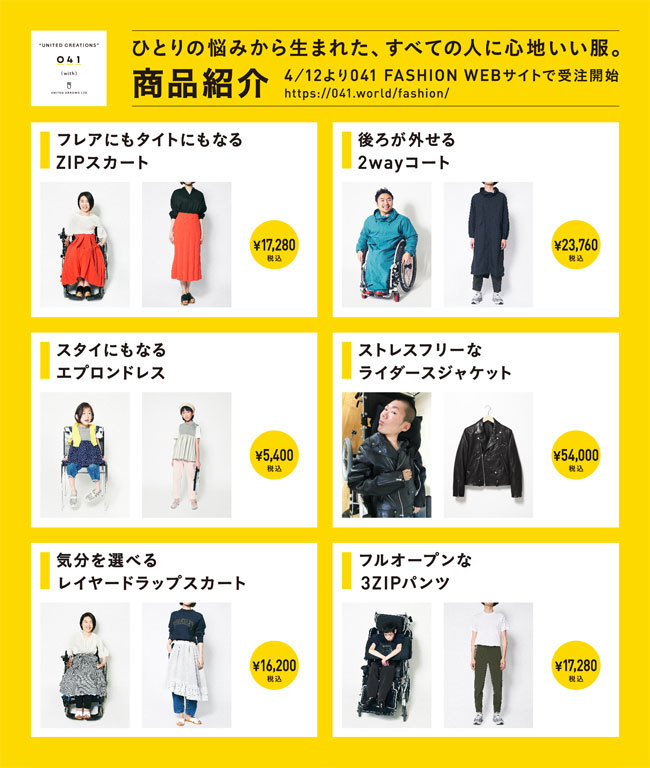Note: This website was automatically translated, so some terms or nuances may not be completely accurate.
"041 FASHION" Born from Inclusive Design
"Build cars everyone can ride," "Create clothes everyone can wear," "Develop theme parks everyone can visit." Mass marketing underpinned Japan's industrialization and post-war growth. Yet, many people were excluded from this vision—those commonly referred to as "people with disabilities."
According to the White Paper on Persons with Disabilities, over 8 million people in Japan hold disability certificates. Some estimates suggest that including those without certificates, around 10 million people have some form of disability.
They face numerous daily struggles. For instance, a visually impaired man who still nervously crosses streets relying on "courage and intuition." A wheelchair user forced to wait two hours to purchase a Shinkansen ticket. A woman with dyslexia who endured suffering because neither her family nor workplace understood her difficulty with reading and writing. Until now, such concerns were often dismissed by companies as "minor voices."
When speaking with corporate marketing and product development teams, I often hear that "needs are saturated." Is that really true? Then why do the everyday frustrations of people with disabilities remain largely unaddressed? Could it be because companies have viewed these minor voices as niche and non-business-worthy?
However, looking back at history reveals numerous innovations originating from people with disabilities. While theories vary, items like lighters, straws, and cardigans are said to have been invented by people with disabilities. The wildly popular fidget spinner is another example.
The approach of incorporating diverse voices, including those of people with disabilities, from the very beginning of product and service development is called "inclusive design." Precisely because Japan has a high proportion of people with disabilities and elderly citizens, shouldn't we be sparking innovation starting from the perspective of those often called socially vulnerable?
This led to the launch of the "041" project. Meaning "ALL FOR ONE," it's a social experiment developing products and services starting from the needs of a single individual. It's being advanced as a project by Social WEnnovators— a social unit of social entrepreneurs from Nippon TV, Dentsu Inc., and JAPAN GIVING—who tackle social issues as a collective of knowledge, transcending organizational and industry boundaries.
So far, we've created "041 SPORTS" for people with disabilities to enjoy, and "041 SOS" to make train travel easier for parents with children or people undergoing medical treatment. Our newest initiative is "041 FASHION."

Co-developing 041 FASHION: Practicality and Style Combined
The struggles of people with disabilities and clothing are inextricably linked. For example, those who are short or underweight often cannot find sizes that fit their body type. Those who are blind cannot coordinate outfits because they cannot see colors. Those with weak muscle strength find clothing difficult to put on and take off.
Couldn't we create new fashion from these very struggles? It was during this thinking that a connection with UNITED ARROWS LTD. (UA) led us to jointly launch the 041 FASHION project.
First, we enlisted the cooperation of five individuals with disabilities and matched each with a dedicated UA special team. Next, we conducted thorough interviews to identify specific, sharp-edged clothing concerns. Based on these insights, we developed prototypes.
We had them try on the prototypes, conducted even sharper and deeper interviews, and followed a process focused not only on practicality like ease of putting on and taking off, but also on design, to complete the fashion items. After more than half a year, six items were ultimately created.

For example, wheelchair user Ayaka Sekine hadn't found a satisfying skirt in over 10 years. Her concerns were numerous: difficulty putting on/taking off, skirt flipping up in the wind, length inevitably shortening when seated, difficulty identifying the center when assisted by caregivers, and seams on the buttocks increasing pressure sore risk. This led to the creation of the "ZIP Skirt that Becomes Both Tight and Flare".

Its key feature is five vertical zippers. Fully unzipped, it becomes a soft, flared skirt; zipped up, it transforms into a tight skirt. The central zipper also serves as a visible centerline marker and helps prevent the skirt from flipping up due to its weight. Furthermore, the functionality of the five zippers, born from specific needs, has resulted in a highly innovative design.
While developed with wheelchair user Ms. Sekine as the starting point, it's crucial to note this isn't solely "for people with disabilities." Starting with one person, it benefits everyone. This is the true essence of inclusive design.
During the 2020 Tokyo Paralympics, people with disabilities will gather in Japan from around the world. I want Japan to leave a legacy as a "diversity pioneer." To achieve this, I believe we must continuously innovate, starting with each individual with a disability. Won't you join us?
Was this article helpful?
Newsletter registration is here
We select and publish important news every day
For inquiries about this article
Author

. .
.